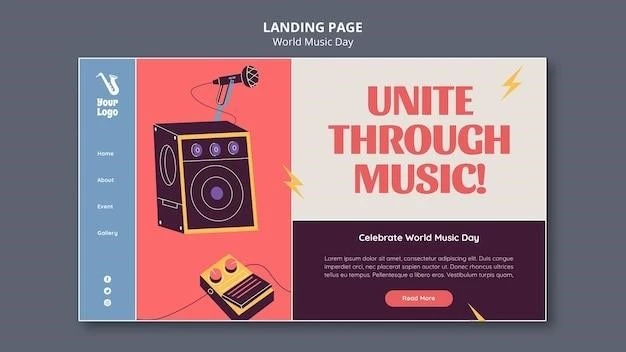Music, a fundamental form of human expression, has been an integral part of our existence for millennia. From ancient rituals to modern-day concerts, music has constantly evolved, reflecting cultural shifts, technological advancements, and artistic innovations. This article delves into the captivating journey of music, exploring its origins, the emergence of various genres, and the factors that have shaped its ever-changing landscape.
Early Beginnings: The Genesis of Musical Expression
While pinpointing the exact origins of music remains a challenge, archaeological evidence suggests that early humans were creating musical sounds as far back as the Middle Paleolithic period, approximately 40,000 years ago. Instruments discovered from this era, such as bone flutes and primitive percussion instruments, indicate an early understanding of sound production and rhythm.
Ancient civilizations played a crucial role in formalizing music. In Mesopotamia, for instance, music was deeply intertwined with religious practices and royal ceremonies. The development of musical notation systems, such as cuneiform tablets detailing musical compositions, highlights the sophisticated understanding of music in these early societies. Similarly, ancient Egypt placed great importance on music, incorporating it into religious rituals, social gatherings, and even work songs.

Ancient Greece and the Foundation of Western Music Theory
Ancient Greece significantly contributed to the development of Western music theory. The Greeks believed in the profound connection between music, mathematics, and the cosmos, with philosophers like Pythagoras exploring the mathematical ratios present in musical scales. The diatonic scale, a fundamental element of Western music, has its roots in ancient Greek musical theory. Greek contributions extended beyond theory to the development of musical instruments, including the lyre and the aulos, a double-reed instrument.
The Middle Ages: Monophony and the Rise of Sacred Music
The Middle Ages (circa 476 to 1400 AD) witnessed the dominance of monophonic music, characterized by a single melodic line. Gregorian chant, named after Pope Gregory I, emerged as a prominent form of liturgical music within the Catholic Church. This unaccompanied, free-flowing vocal music emphasized spiritual contemplation and became a cornerstone of Western musical tradition.
Towards the latter part of the Middle Ages, polyphony, music with multiple independent melodic lines, began to emerge. Composers like Hildegard von Bingen and Léonin explored the possibilities of combining different vocal parts, paving the way for the rich harmonic language of the Renaissance.

The Renaissance: A Rebirth of Artistic and Musical Expression
The Renaissance (circa 1400 to 1600) marked a period of significant cultural and artistic transformation in Europe. In music, this era brought a renewed interest in ancient Greek and Roman ideals, leading to a shift from the predominantly religious music of the Middle Ages towards more secular forms of expression.
Polyphony flourished during the Renaissance, with composers like Giovanni Pierluigi da Palestrina and William Byrd creating intricate and harmonious choral works. The invention of music printing around the mid-15th century played a pivotal role in disseminating musical scores and expanding the reach of composers and their creations.
The Baroque Period: Ornate, Dramatic, and Emotionally Charged
The Baroque period (circa 1600 to 1750) ushered in an era of opulence and grandeur in music. Characterized by its ornate melodies, dramatic contrasts, and complex harmonies, Baroque music aimed to evoke a wide range of emotions, from joy and exuberance to solemnity and introspection.
Key figures of the Baroque period include Johann Sebastian Bach, renowned for his mastery of counterpoint and fugue, and George Frideric Handel, celebrated for his operas and oratorios. The development of new musical forms, such as the concerto and the sonata, expanded the expressive possibilities for composers and performers.
The Classical Era: Balance, Clarity, and Formal Structure
The Classical era (circa 1730 to 1820) emphasized balance, clarity, and formal structure in music. Composers like Wolfgang Amadeus Mozart and Ludwig van Beethoven epitomized the Classical style with their elegant melodies, refined harmonies, and adherence to established musical forms.
The symphony, a large-scale orchestral work typically consisting of four movements, reached its pinnacle during the Classical period. The development of the piano as a versatile and expressive instrument also significantly impacted the musical landscape of this era.
The Romantic Era: Emotion, Individuality, and Programmatic Music
The Romantic era (circa 1820 to 1900) witnessed a shift towards emotional expression, individuality, and programmatic music, where musical ideas were often inspired by literary or visual sources. Composers like Franz Schubert, Johannes Brahms, and Pyotr Ilyich Tchaikovsky explored themes of love, nature, and nationalism in their works.
The Romantic era saw the rise of virtuosic performers, such as Niccolò Paganini on the violin and Franz Liszt on the piano, who captivated audiences with their technical brilliance and passionate interpretations.
The 20th Century and Beyond: A Tapestry of Innovation and Experimentation
The 20th century marked a period of unprecedented innovation and experimentation in music. The advent of new technologies٫ such as recording and broadcasting٫ dramatically expanded the reach and accessibility of music. Composers challenged established norms٫ exploring new sonic possibilities and pushing the boundaries of musical expression.
- Impressionism: Claude Debussy and Maurice Ravel sought to evoke moods and atmospheres through subtle harmonies and evocative timbres.
- Expressionism: Arnold Schoenberg and Igor Stravinsky challenged traditional tonality, using atonality and dissonance to express intense emotions.
- Jazz: Originating in the African American communities of New Orleans, jazz emphasized improvisation, syncopation, and a distinctive rhythmic feel.
- Blues: Rooted in the African American experience, blues music expressed themes of sorrow, hardship, and resilience.
- Rock and Roll: Emerging in the 1950s, rock and roll combined elements of blues, country, and gospel, becoming a global phenomenon.
- Electronic Music: Pioneered by composers like Karlheinz Stockhausen and Pierre Schaeffer, electronic music utilized electronic oscillators, tape recorders, and computers to generate and manipulate sound.
- Hip-Hop: Originating in the 1970s in the Bronx, New York, hip-hop combined rhythmic spoken word (rapping) with DJing, breakdancing, and graffiti art.
Music in the Digital Age: Accessibility, Globalization, and New Frontiers
The late 20th and early 21st centuries have witnessed the transformative impact of digital technologies on music. The internet and digital audio workstations (DAWs) have democratized music production٫ distribution٫ and consumption٫ making it easier than ever for artists to create and share their music with a global audience.
Streaming services have revolutionized how people consume music, providing access to vast catalogs of songs from around the world. Social media platforms have become essential tools for artists to connect with fans, promote their music, and build communities.
Conclusion: Music as a Reflection of Our Shared Humanity
The evolution of music is a testament to human creativity, adaptability, and our innate desire to connect with each other through shared experiences. From the rhythmic chanting of our ancient ancestors to the digitally produced soundscapes of today, music continues to play an integral role in shaping our cultural identities, expressing our emotions, and enriching our lives.
As technology continues to evolve and cultural landscapes shift, music will undoubtedly continue to transform, offering new possibilities for artistic expression and pushing the boundaries of what we thought possible. The journey of music is far from over; it is an ongoing symphony, constantly evolving, adapting, and reflecting the ever-changing world around us.










